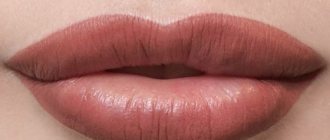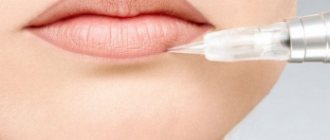Date of publication: 07/20/2017 Date of update: 10/26/2021 11703
Tattooing is the introduction of colored pigment under the skin using a thin needle. Depth – approximately 0.5-1 mm, area of influence – hairy part of the eyebrows. If the shape of the eyebrows needs to be changed, then the dye is applied beyond the boundaries of hair growth. This is also often done if the eyebrows are naturally very thin and you want to make them wider.
In the first days after the tattoo procedure (permanent makeup), eyebrows need care. Damaged skin should not be exposed to aggressive influences. In addition, until healing is complete, eyebrows do not look very beautiful. Therefore, plan a few days of “home” regimen after the procedure. If going outside is unavoidable, buy large sunglasses that cover your eyebrows.
Healing process
Immediately after the introduction of the pigment, the skin becomes inflamed, red, and swollen, but the next day it subsides. This is a natural reaction of the dermis to multiple needle punctures. The treatment area may “bleed” slightly, and ichor is released from it. The entire healing process, if the rules and recommendations are followed, takes up to 10 days. However, this period is purely individual. The main thing is to follow the instructions of the specialist who performed the procedure.
Recovery stages
The entire healing period can be divided into several stages:
- For the first 3 days, the eyebrows have a reddish tint, and a small amount of ichor is released.
- Over the next week, crusts form and fall off over time.
- After 10 days, the crusts disappear, the skin begins to peel off, increasing the brightness of pigmentation. After 14 days, the wounds heal, the skin is completely restored with new pigmentation.
- After a month, the skin is completely restored, the eyebrows acquire a natural shade and desired shape.
Everyone has their own healing time. It depends on the characteristics of the body and the method of tattooing. For example, when using the spraying method, fewer areas of the dermis are affected, so skin restoration occurs faster.
Washing after the procedure
wash your face in the usual way for the first 3-4 weeks after tattooing.
Note! In the first week, it is better not to do this at all, and if necessary, you should wipe your face with wet wipes.
Water that gets on the drying crust will contribute to the disruption of its integrity, and even if it does not cause additional inflammation, it can significantly slow down the healing process.
Naturally,
a full shower and bath, as well as visiting pools and beaches, are prohibited at this time .
Rules of care
The cosmetologist who performed the procedure should tell you in detail how to properly care for your eyebrows after tattooing. In the standard version, this looks like several mandatory skin care rules:
- After washing, do not use a rough towel. Remove moisture from the face using a soft cloth using small blotting movements.
- You should not peel off the crust that has formed; it must fall off on its own, otherwise the pigment will be absorbed unevenly.
- Try to avoid getting water into the tattoo area. Along with the liquid, an infection can be introduced, so you should wash your hair in advance.
- Do not take a hot bath or shower, and also refrain from going to the bathhouse or sauna until the skin has completely healed. When the skin is steamed, swelling and redness may increase.
- Do not use cosmetics, or wash your face with soap, foams, or gels containing alcohol.
- Avoid exposure to direct sunlight. In summer, it is recommended to use UV protection.
- Try to touch the tattooed area as little as possible. Do not remove or shave hairs near the eyebrow arches.
- While the recovery process is underway, you should not engage in active sports, as sweat can get on your eyebrows and cause an infection.
If you follow the rules, the risk of infection will be minimal. Proper skin care after permanent makeup is an important part of creating your beautiful look. If they are not followed, swelling and redness may intensify, hematomas will occur, and instead of a beautiful look, you will get many problems that will have to be addressed by a doctor.
Skin care after tattooing
On the first day after the procedure, the upper layer of the epidermis becomes inflamed and swollen, and in some cases blood may appear. This is the body's natural reaction to the multiple injuries caused by needles. Redness and swelling go away the next day, since the depth of the damage is very small. The complete healing process with proper care takes from 14 days to a month. But everyone’s body is individual, so these timings can be adjusted.
In the first days, the color of the eyebrows looks much brighter and unnatural, but as it heals, everything comes back to the way it was planned. Do not try to somehow disguise this process, this can cause harm and worsen the condition of the skin.
Is it possible to combine the procedure with alcohol?
Alcohol is an enemy of any invasive procedures , since alcohol increases blood pressure and any incisions and punctures begin to bleed heavily.
It is necessary to stop drinking alcohol one day (or preferably 2-3 days) before tattooing .
Otherwise, the following consequences are possible:
- tissue inflammation, as a result of which the regeneration processes will obviously proceed more slowly;
- increased leaching of paint with blood already during the procedure, and as a result – faded, uneven colors and contours that will have to be modified;
- vasodilation, which negatively affects the client’s condition as a whole;
- increasing the likelihood of contracting an infection. Some bacteria are inevitably introduced through punctures during the tattooing process, but the body can easily cope with them if the immune system is not suppressed by alcohol.
You should not drink for the next three days , as bleeding may occur and the paint will again be washed out.
Keep in mind! Ideally, it is better to avoid alcohol for the entire healing period.
First day after tattoo
The first day is considered the most difficult. The eyebrow ridges will hurt and ichor will be released, which will harden and tighten the skin. To remove the ichor, use cotton pads and blot the tattoo area using gentle movements in the direction of hair growth and drawing. You can use light ointments for pain relief.
On the first day, try to touch your eyebrows as little as possible. Antiseptic agents are used when treating skin:
- miramistin;
- non-alcoholic solution of 0.05% chlorhexidine;
- Vishnevsky ointment;
- levomekol;
- aqueous solution of furatsilin.
The antiseptic is applied to the skin using a spray or clean cotton swabs. You cannot use cosmetics or products that are not included in the list of products recommended by the cosmetologist. During the first healing period, try not to scratch the tattooed area and avoid unnecessary contact with water to prevent infection.
Second day after permanent eyebrow makeup
On the second day after sleep there is a noticeable increase in color. This is considered normal, since during sleep the ichor is released along with the pigment. During this time, it hardens and turns into a solid dark crust. Skin care must continue as on the first day: blot the tattooed areas with cotton swabs with antiseptic agents.
On the second day, the secretion of ichor becomes significantly less, so the treatment procedure can be reduced to 4 times a day. At the end of the second day, pain and swelling become less.
Care for the eyebrow tattoo area for 3-5 days
On the 5th day after the procedure, the crust begins to disappear, which confirms the correctness of the skin care and restoration process. From now on, it is allowed to use healing ointments or creams. The treatment course lasts 7 days.
After removing the crusts, there is a feeling of tightness and dryness of the skin, which is especially noticeable in the morning. You can solve the problem with Vaseline or baby cream. It should be applied after washing for 20 minutes, then removed. You are still not allowed to use cosmetics.
The following are used as healing ointments that can be applied:
- beponten;
- depanthenol;
- oxolinic ointment with antiviral properties;
- contractubex;
- solcoseryl;
- Vasiline.
Do not use alcohol-based ointments. Choose those that contain natural, natural ingredients. They will help not only with the rapid healing of wounds, but also soften and moisturize damaged areas of the skin.
Material and methods
The research was carried out in several directions. At the first stage, as units of analysis, we selected PubMed publications from 1997 to 2022, devoted to complications after tattooing. The analysis categories combined keywords characterizing the occurrence of complications associated with tattooing. The keywords used were words and phrases such as “tattoo”, “tattoo”, “adverse effects”, “complications of tattoo”, “reaction to tattoo”, as well as various diagnoses in combination with the word “tattoo”.
At the same time, we have accumulated a database of patients in the department of laser therapy and other hardware methods of treatment and diagnosis of the Moscow Scientific and Practical Center for Dermatovenereology and Cosmetology with complications after performing the tattoo procedure.
Clinical and laboratory diagnostics included anamnesis, examination, dermatoscopy, allergy tests, bacteriological examination, immunofluorescence tests, enzyme-linked immunosorbent assay, and in some cases a pathomorphological examination of tattoo tissue biopsies was performed. For this purpose, the material was placed in 10% formaldehyde for 24 hours, embedded in paraffin blocks and followed by standard processing, staining of sections with hematoxylin and eosin and Van Gieson. Microphotographs were taken using a Leica DM 100 microscope with a digital camera.
Statistical processing was carried out using methods generally accepted for medical and biological research using the Excel 7.0 (Microsoft, USA) and ARKADA (Dialog-MSU, Russia) software packages.
Eyebrow care after 7-10 days
At the end of the first week after the procedure, the crusts, pain, and swelling go away, but discomfort in the arch area remains, associated with peeling and dry skin. This is due to several reasons:
- Excessive drying of the skin.
- Allergic reaction to pigment.
- Removal of crusts.
To avoid flaking and itching, use moisturizing ointments based on herbal products.
At the end of the first week, the resulting crusts completely disappear, but treatment with an antiseptic and moisturizer must be continued. Now you can see the shade of the injected dye, the updated shape and volume of the eyebrows. The color has not yet fully set. It will be brighter than planned, but every day its intensity will decrease, the shade will become more natural.
During this period, active restoration of a new layer of the epidermis begins, the wounds heal, and the recovery process is almost complete on days 10-14.
Eyebrows a month after tattooing
If all skin care procedures were carried out correctly, after a month the new layer of epidermis will be completely restored and the final result of the new eyebrow arches can be assessed. At this point, the shortcomings and mistakes made when choosing the shape and shade of the pigment are visible. If any defects are identified, you should contact your technician to have them eliminated. Defects can have different causes:
- Poorly performed procedure.
- Incorrectly selected pigment tone.
- Failure to follow the rules of care after tattooing.
- Use of non-certified materials.
The resulting defects can be corrected and completely eliminated. All additional procedures to eliminate defects are carried out only after complete healing of the upper layer of the epidermis.
Noticed deficiencies can be recorded on your phone and shown to the specialist who will make the correction. If you are not completely satisfied with the result, it is better to replace the artist or the salon where the procedure was performed and remove the tattoo completely.
Tattoo reduction: what can affect the effect?
The size of the tattoo, its age, the quality of the ink and the skill of the artist all affect the skin.
Before choosing a method of mixing, consult a cosmetologist for contraindications, and, if possible, contact the artist who created the drawing: find out what pigment he used and what its composition is. This will help you better choose a method for removing an unwanted tattoo. In addition, whether a scar appears after tattoo removal or not depends on many factors:
- Professional tattoos take longer and are more difficult to remove than the work of a bad specialist. This is due to the number of details in the design, the quality of the material and the area of the fragment.
- Skin type. Affects the choice of mixing method and the final effect of the procedure. Dark skin is more receptive to laser and less sensitive than light skin.
- Laser. When choosing this method, a constant wavelength and pulse frequency are important. It is necessary to carefully select the device on which the procedure will be performed.
- Tattoo color. The easiest one to remove is a single-color tattoo made with black paint. Colored tattoos are more difficult to remove because the pigments have a more complex composition.
It is worth considering that it will not be possible to remove a tattoo in one session. For extensive tattoos, you will have to visit the artist up to 8 times; small and medium tattoos will require 3–5 visits.
Non-standard situations
Each body reacts to the administration of the drug in its own way. Sometimes allergic reactions to the pigment may occur. If after the procedure the swelling and redness do not go away within 24 hours and spread to the eyelids, you should take antihistamines:
- suprastin;
- lorantandine;
- tavigil;
- Zyrtec or other anti-allergy drugs.
Observation of the body's reaction takes place within 4-8 hours. If the allergy does not go away, the pigment will have to be removed and the pattern removed.
In cases of infection of the eyebrow arches, a doctor's examination and medical intervention will be required. Be sure to take blood tests to determine the causes of skin inflammation.
Swelling after permanent makeup: what to do
Swelling of the arches after the tattooing procedure is a completely natural phenomenon, because in the process the upper layer of the epidermis is damaged. The body responds to minor damage to the skin with edema. In addition, the cells of the dermis react to the injected drug, which is foreign to them.
In normal conditions, swelling and redness go away after a couple of days. If swelling persists longer and is accompanied by pain and itching, you should consult a dermatologist. At home, you can take an anti-allergenic agent, since the most common cause of this situation is the occurrence of an allergic reaction to the injected pigment.
Tattoo removal methods
Tattooing is an ancient tradition of decorating the body, and methods of tattooing also go back centuries. Our ancestors did not think about whether scars remained after tattoo removal, so folk remedies are quite harsh:
- Just cut off the skin with a knife. The procedure was so painful that the person was tied up, vodka was poured over the desired area, and he was cut. It is not surprising that the scar could be twice the size of a bad tattoo.
- Salt compresses. Salt not only corrodes paint, but also injures epidermal tissue.
- Iodine nets.
- Manganese dressings.
- Celandine juice.
It is important to remember that using the methods listed above, you cause more damage to the skin than a needle and paint, severely injuring it. Damaged tissues may not heal properly - due to external influences, the normal production of collagen, the main building material of our skin, is disrupted.
Thus, hypertrophic and keloid scars arise: an undesirable relief represented by excess collagen. Such scars rise above the skin level, are red or bluish in color, and cause itching and discomfort. Read more about how to deal with keloid scars in our article: Treatment of keloid scars.
Modern cosmetological methods of tattoo removal are more humane:
- Cryoremoval. Removing a tattoo using liquid nitrogen - during interaction with it, the cells freeze and die along with the injected pigment. After tattoo removal, the scars will definitely remain, they will have to be removed separately.
- Electrical processing. Burning of skin cells with high voltage current. The process is painful, but tolerable. After the procedure, rough scars remain.
- Treatment with chemicals. With an experienced master, there should be no scars. The meaning of the procedure is to rub substances into the skin that discolor the paint.
- Dermabrasion. Scraping the stratum corneum of the epidermis with a cutter with a diamond tip. If the puncture with paint was made shallowly, then there will be no scars left. However, the procedure is painful and will require several sessions followed by long-term rehabilitation.
- Laser. The most expensive method, but it is one of the most effective. He is able to remove the drawing almost without a trace. But even after laser resurfacing, scars often remain that require correction.
It’s better not to skimp on your appearance: celandine and other folk remedies can do more harm than help. The same applies to an incorrectly selected cosmetic procedure.
How do you know if a tattoo removal scar will remain?
Features of care at different times of the year
The restoration of the epidermis after permanent makeup is influenced by the period of its implementation. During the warm season, cells secrete more sebum, which makes the dermis oily. At the same time, in the summer there is a lot of dust and dirt in the air, which means the risk of infection increases. Ultraviolet radiation negatively affects the pigment, discoloring it. Therefore, when carrying out tattooing in the summer, you should adhere to the following rules:
- Be sure to use a cream with 30-50 SPF protection.
- For the first 10 days, you should not stay in the sun for a long time, sunbathe or sunbathe. If you are planning a trip to the south, plan to get a tattoo a month before your trip.
- After the crusts come off, use a cream with vitamins A, C, B to moisturize. This will protect against swelling and dry skin.
In winter, when the cold wind dries out the skin and the immune system weakens, healing of the dermis takes longer. The skin is constantly exposed to sudden changes in temperature, which has a detrimental effect on its condition; the following tips will help change the situation:
- A week before the planned procedure, take vitamin complexes and immunostimulants to strengthen the body.
- After 4 days, use Vaseline-based ointment to improve skin regeneration and healing.
- Apply a moisturizer with vitamins 3-5 hours before going outside.
It is important that after permanent eyebrow tattooing, you know how to properly treat the skin in the areas where it is applied, this will help avoid complications.
In the end, we note that permanent eyebrow makeup will be an excellent solution for all modern women who, due to lack of time, do not have time to apply makeup in the morning. At the same time, eyebrow tattooing allows you to improve the color and adjust the shape of the arches, which cannot be done as naturally as possible with regular paint or pencil.
What does it feel like?
You will only feel tingling and warmth. If you feel pain, you should tell a specialist about it, and he will reduce the strength of the impulse. Remember that the degree of pain of the procedure depends on the location of the pattern and on the individual pain threshold. After the first session, the tattoo may noticeably lighten and then darken again. This is a normal reaction, as is slight swelling and redness of the skin. The doctor takes photos of the tattoo before and after each session for comparison. Remember that in order to completely remove a design with a laser, you must use it responsibly. Refer to the comments of a specialist doctor and follow all recommendations. Remove tattoos, remove eyebrow tattoos with laser, remove permanent makeup on lips and eyelids.











